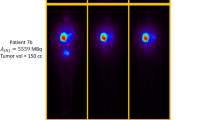Abstract
The purpose of this study was to analyse the biodistribution of rhenium-188 Lipiodol in rats with hepatic tumours following intrahepatic arterial injection to assess the potential of188Re-Lipiodol as a radiopharmaceutical for the treatment of hepatic tumours in humans. Twelve male rats with hepatic tumours were killed at 1 h, 24 h and 48 h after injection of approximately 7.4 MBq of188Re-Lipiodol via the hepatic artery. Samples of various organs were obtained and counted to calculate the tissue concentration. Radioactivity in the hepatic tumours was very high throughout this study, with a biological half-life of 122.9 h. Radioactivity in the normal liver tissue was also high, but was significantly lower than in the tumour. The biological half-life in the normal liver tissue was 31.7 h. The ratio of tumour concentration to the normal liver tissue concentration was 5.15 at 1 h and rose to 7.7 at 24 h and 10.84 at 48 h. The level of radioactivity in the lung was high at 1 h, and declined rapidly over time. The level of radioactivity in the kidney was moderate throughout the study. The radiation concentrations in muscle, spleen, testis, bone and whole blood were insignificant. We conclude that188Re-Lipiodol should be considered as a potential radiopharmaceutical for the intra-arterial treatment of hepatic tumours.
Similar content being viewed by others
References
Takayasu K, Shima Y, Muramatsu Y, et al. Hepatocellular carcinoma: treatment with intraarterial iodized oil with and without chemotherapeutic agents.Radiology 1987; 162: 345–351.
Report on patient survey in hospital and clinics in Taiwan area. Department of Health, the Executive Yuan, 1992.
Kanematsu T, Inokuchi K, Sugimachi K, et al. Selective effects of lipiodolized antitumor agents.J Surg Oncol 1984; 25: 218–226.
Konno T, Maeda H, Iwai K, et al. Effects of arterial administration of high molecular weight anticancer agent SMANCS with lipid lymphographic agent on hepatoma: a preliminary report.Eur J Cancer Clin Oncol 1983; 19: 1053–1065.
Nakakuma K, Tashiro S, Hiraoka T, et al. Studies on anticancer treatment with an oily anticancer drug injected into the ligated feeding hepatic artery for liver cancer.Cancer 1983: 52: 2193–2200.
Maki S, Konno T, Maeda H. Image enhancement in computerized tomography for sensitive diagnosis of liver cancer and semiquantitation of tumor selective targeting with oily contrast medium.Cancer 1985; 56: 751–757.
Ohishi H, Uchida H, Yoshimura H, et al. Hepatocellular carcinoma detected by iodized oil: use of anti-cancer agents.Radiology 1985; 154: 25–29.
Yumoto Y, Jinno K, Tokuyama K, et al. Hepatocellular carcinoma detected by iodized oil.Radiology 1985; 154: 19–24.
Nakamura H, Hashimoto T, Oi H, Sawada S. Transcatheter oily chemoembolization of hepatocellular carcinoma.Radiology 1989; 170: 783–786.
Kobayashi H, Hidaka Y, Tanque P, et al. Treatment of hepatocellular carcinoma by transarterial injection of anticancer agents in iodized oil suspension or of radioactive iodized oil solution.Acta Radiol Diagn 1986; 27: 139–147.
Park CH, Suh JH, Yoo HS, Lee JT, Kim DI. Evaluation of intrahepatic I-131 Ethiodol on a patient with hepatocellular carcinoma.Clin Nucl Med 1986; 11: 514–517.
Raoul JL, Duvauferrier R, Bourguet P, et al. Lipiodolized angiography with I-131-iodine labeled iodized oil in malignant hepatoma.J Radiol 1986; 67: 797–801.
Madsen MT, Park CH, Thakur ML. Dosimetry of iodine-131 Ethiodol in the treatment of hepatoma.J Nucl Med 1988; 29: 1033–1044.
Farnsworth APH, Vaughan ATM. The influence of free DTPA on the dose distribution of yttrium-90 radiolabelled antibodies.Int J Rad Appl Instrum [B] 1988; 499–504.
Chen MN, Wang SJ, Kao CH, Tsai ZT. A column method for Lipiodol labeling with yttrium-90 [abstract].J Nucl Med 1994; 35: 241p.
Wang SJ, Lin WY, Chen MN, Shen LH, Tsai ZT, Ting G. Preparation and biodistribution of Y-90 lipiodol in rats following hepatic arterial injection.Eur J Nucl Med 1995; 22: 233–236.
Callahan AP, Rice DE, Knapp FF Jr. Availability of Re-188 from a tungston-188/Re188 generator system for therapeutic applications [abstract].J Nucl Med 1987; 28: 657p.
Breedis C, Young G. The blood supply of neoplasms of the liver.Am J Pathol 1954; 30: 969–977.
Park C, Choi SI, Kim H, Yoo HS, Lee YB. Distribution of Lipiodol in hepatocellular carcinoma.Liver 1990; 10: 72–78.
Nakakuma K, Tashiro S, Hiraoka K, Ogata K, Ootsuka K. Hepatocellular carcinoma and metastatic cancer detected by iodized oil.Radiology 1985; 154: 15–17.
Iwai K, Maeda H, Konno T. Use of oily contrast medium for selective drug targeting to tumor: enhanced therapeutic effect and X-ray image.Cancer Res 1984; 44: 2115–2121.
Ngan H. Lipiodol computerized tomography: how sensitive and specific is the technique in the diagnosis of hepatocellular carcinoma?Br J Radiol 1990; 63: 771–775.
Kobayashi H, Inoue H, Shimada J, et al. Intra-arterial injection of Adriamycin/mitomycin C Lipiodol suspension in liver metastases.Acta Radiol 1987; 28: 275–280.
Kan Z, Ivancev K, Hagerstrand I, Chuang V, Lunderquist A. In vivo microscopy of the liver after injection of Lipiodol into the hepatic artery and portal vein in the rat.Acta Radiol 1989; 30: 419–425.
Okuda K, Musha H, Yamasaki T, et al. Angiographic demonstration of intrahepatic arterioportal anastomoses in hepatocellular carcinoma.Radiology 1977; 122: 53–58.
Bledin AG, Kantarjian HM, Kim EE, et al.99mTc-labeled macroaggregated albumin in intrahepatic arterial chemotherapy.AJR 1982; 139: 711–715.
Ziessman HA, Thrall JH, Gyves JW, et al. Quantitative hepatic arterial perfusion scintigraphy and starch microspheres in cancer chemotherapy.J Nucl Med 1983; 24: 871–875.
Bayouth JE, Macey DJ. Dosimetry consideration of boneseeking radionuclides for marrow ablation.Med Phys 1993; 20: 1089–1096.
Mantravadi RVP, Spigos DG, Karesh SM, et al. Intra-arterial P-32 chromic phosphate for the prevention of post operative liver metastases in high risk colorectal cancer patients.Radiology 1983; 148: 555–559.
Author information
Authors and Affiliations
Rights and permissions
About this article
Cite this article
Wang, SJ., Lin, WY., Chen, MN. et al. Biodistribution of rhenium-188 Lipiodol infused via the hepatic artery of rats with hepatic tumours. Eur J Nucl Med 23, 13–17 (1996). https://doi.org/10.1007/BF01736984
Received:
Revised:
Issue Date:
DOI: https://doi.org/10.1007/BF01736984




